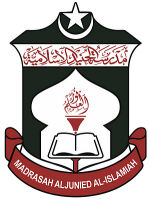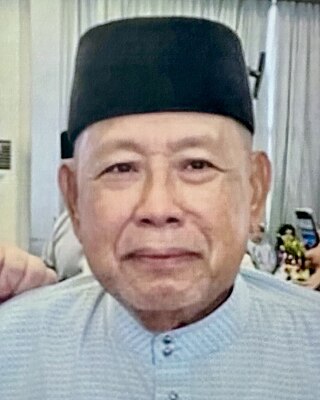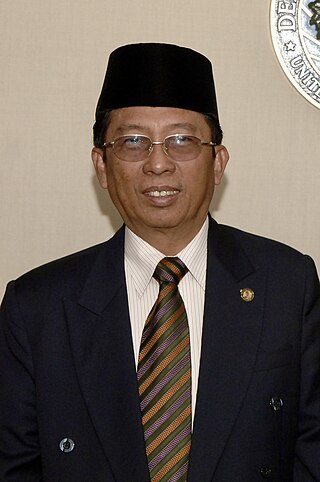Queenstown Secondary School (QTSS) is a co-educational government secondary school in Queenstown, Singapore. QTSS was one of the 28 schools selected by the Ministry of Education to start piloting aspects of Full Subject-Based Banding from 2020 onwards due to its ability to help students fulfil their potential. This includes reorganised form classes of varying academic abilities. The school was featured by MOE for its strong culture of care in partnership with parents

Kampong Kilanas or commonly known as Kilanas, is a village in Brunei-Muara District, Brunei, on the western outskirts of the capital Bandar Seri Begawan. The population was 4,589 in 2016. It is one of the villages within Mukim Kilanas.

Madrasah Aljunied Al-Islamiah is a full-time, private Islamic institution of learning in Singapore, one of the six such madrasahs in Singapore. Madrasah Aljunied is one of the oldest surviving madrasahs in Singapore. Through its years, it has gained eminence for its high standard of Arabic language and Islamic scholarship in the region. Madrasah Aljunied boasts an illustrious line of alumni of prominent Islamic religious leaders in Singapore and Southeast Asia.

Lim Jock Seng is a Bruneian aristocrat, anthropologist, politician and diplomat who served as first Minister of Foreign Affairs & Trade II. Additionally, he was a member of the Privy Council in 2003, and Legislative Council of Brunei in 2004. Other than holding government offices, he was also the chairman of Brunei Shell Petroleum (BSP) and Royal Brunei Airlines (RBA) from 2008 to 2010.

The Duli Pengiran Muda Al-Muhtadee Billah College, colloquially known as Maktab Duli (MD), is a government sixth form college located at Jalan Pasar Gadong in Bandar Seri Begawan, Brunei. Established in 1974, it is the first sixth form centre in the country, and has since provided sixth form education leading up to GCE A Level qualification.

The Sultan Omar 'Ali Saifuddien College (SOASC), natively known as Maktab Sultan Omar 'Ali Saifuddien (MSOAS), is a government boys' secondary school in Bandar Seri Begawan, the capital of Brunei. It is the first English secondary school in the country. The school is also one of the only three boys' secondary schools nationwide, with the other two being Muda Hashim Secondary School and Ma'had Islam Brunei. The school provides five years of secondary education leading up to GCE 'O' Level and IGCSE qualification.

The Ministry of Education is a cabinet-level ministry in the government of Brunei which oversees education in the country. It was established immediately upon Brunei's independence on 1 January 1984. It is currently led by a minister and the incumbent is Romaizah Mohd Salleh who took office since 7 June 2022. The ministry is headquartered in Bandar Seri Begawan.

The Ministry of Health is a cabinet-level ministry in the government of Brunei which oversees the health system in the country. It is currently led by a minister and the incumbent is Mohd Isham Jaafar, who took office since 1 December 2017. The ministry is headquartered in Bandar Seri Begawan.

Sultan Hassan Secondary School is a government secondary school located in Kampong Batu Apoi of Temburong District, Brunei. It is the only secondary school in the district, and the first school in the district to offer adult education in 1968.

Adina binti Othman @ Chua is a Bruneian bureaucrat of Chinese descent whom served as the Deputy Minister of Culture, Youth and Sports between 2010 and 2015 and was the first woman in Brunei to hold the position of the deputy minister.

Mustappa bin Haji Sirat is a diplomat and politician in the Government of Brunei. He took office as the Minister of Communications from 2015 to 2018 and also as the Deputy Minister of Defence.

Kampong Lambak Kiri is a village in the north of Brunei-Muara District, Brunei. The population was 2,791 in 2016. It is one of the villages within Mukim Berakas 'A'. The postcode is BB1214.

Kampong Tasek Meradun or simply known as Tasek Meradun, is a village in Brunei-Muara District, Brunei, as well as a neighbourhood in the capital Bandar Seri Begawan. The population was 400 in 2016. It is one of the villages within Mukim Kilanas. The postcode is BF1520.

Kampong Bukit Udal or simply known as Bukit Udal, is a village in Tutong District, Brunei, about 11 kilometres (6.8 mi) from the district town Pekan Tutong. It has an area of 13 square kilometres ; the population was 1,306 in 2016. It is one of the villages within Mukim Tanjong Maya, a mukim in the district.

Madrasah Alsagoff Al-Arabiah is one of the six full-time Madrasahs in Singapore recognised by Majlis Ugama Islam Singapura (MUIS). It is known for its academic emphasis on its language and religious subjects.
The Most Eminent Order of Islam Brunei, also translated as The Most Illustrious Islamic Religious Order of the State of Brunei, is an order of Brunei. It was established on 1 August 1968 by Sultan Hassanal Bolkiah for service in the propagation, preservation and strengthening of the Islamic religion.

Yahya bin Bakar, also referred to Pehin Dato Yahya Bakar, is a Bruneian aristocrat and politician whom formerly held the position of Minister of Energy from 2005 to 2008, and Minister of Industry and Primary Resources from 2008 to 2015.

Abdullah bin Haji Bakar, also referred to as Pehin Dato Abdullah Bakar, is a Bruneian aristocrat and politician who took office as the Minister of Communications from 2010 to 2015, and Minister of Development from 2005 to 2010.

Pengiran Mohammad bin Pengiran Haji Abdul Rahman, pen name Zairis M.S., is a Bruneian politician and writer in the Government of Brunei whole formerly took office as the second Minister of Religious Affairs from 2010 to 2015, and Deputy Minister of Education from 2005 to 2010.
Yusoff bin Haji Ismail is a Bruneian politician and diplomat who was the Deputy Minister of Education from 2010 to 2015, and the Ambassador of Brunei to Saudi Arabia from 2016 to 2024.
















